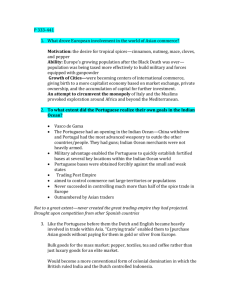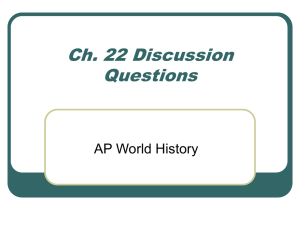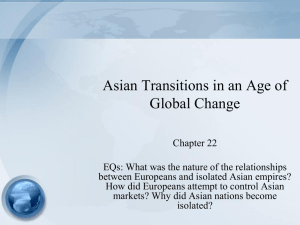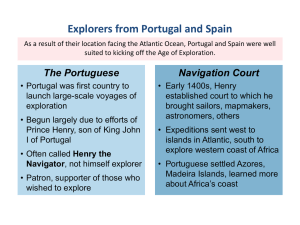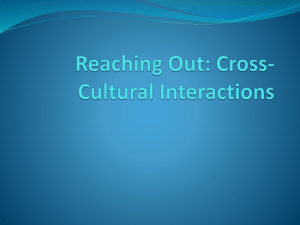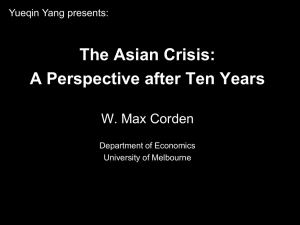Europeans and Asian Commerce
advertisement
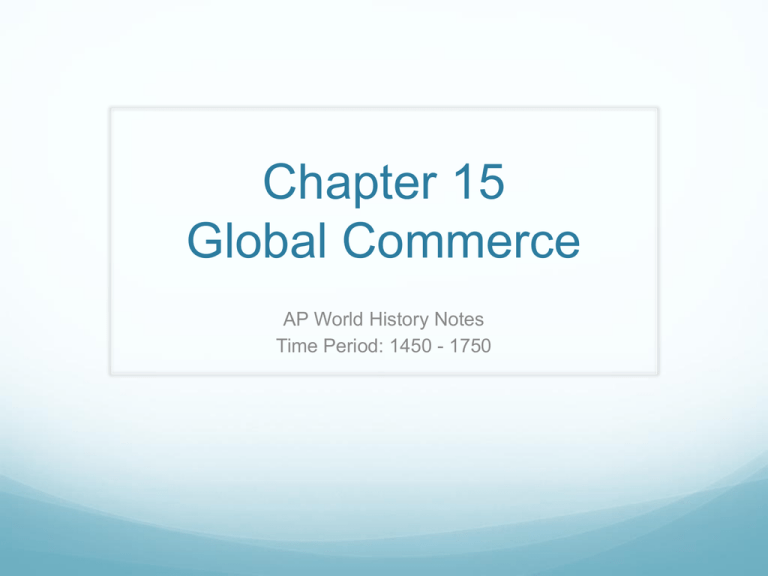
Chapter 15 Global Commerce AP World History Notes Time Period: 1450 - 1750 Europeans and Asian Commerce European countries that got involved in Asian commerce = first the Portuguese, then the Spanish, French, Dutch, and British Motivations for European involvement in Asian commerce: Exotic spices = cinnamon, nutmeg, mace, cloves, and pepper Chinese silk Indian cotton and rhubarb Precious gems = emeralds, rubies, and sapphires Europeans and Asian Commerce At the time = Eastern goods came into the Mediterranean through the Middle East from the Indian Ocean Europeans’ problems with this: Source of supply of goods = Muslim merchants who charged heavy taxes Once it got to Europe = Italian merchants (especially from Venice) had a monopoly over trade of these Asian products They had no valuable products to trade in return so they had to pay in gold or silver for Asian goods Europeans and Asian Commerce Goal of Europeans in Asia = trade, not empire-building A Portuguese Empire of Commerce Portugal had to use its military to secure trade bases within the Indian Ocean did not have attractive goods that it could use to establish itself within the trade network Easy to do because: They had more advanced technology and weapons Merchant ships in the Indian Ocean weren’t heavily armed Portuguese ships had cannons; merchant ships did not A Portuguese Empire of Commerce Portugal set up fortified trade bases in: Mombasa in East Africa Hormuz at the entrance to the Persian Gulf Goa on the west coast of India Malacca in Southeast Asia Macao on the south coast of China A Portuguese Empire of Commerce Portugal created a “trading post empire” within the Indian Ocean Goal = control commerce, not large territories or populations Goal = control trading posts by force of arms, not by economic competition Major thing Portugal controlled = the spice trade Portuguese Policies in the Indian Ocean Required all merchant vessels to purchase a cartaz (pass) to sail throughout the region Charged merchant vessels taxes of 6-10% of their cargoes Blocked the Red Sea route to the Mediterranean Sea Monopolized the trade route around Africa to Europe Portuguese Control in the Long-Run Portugal never succeeded in controlling more than half of the spice trade to Europe By 1600 = the Portuguese trading post empire was in steep decline Competition from other European powers Competition from rising Asian states like Japan and Mughal India Portuguese Control in the Long-Run Portuguese just assimilated themselves into the old, traditional patterns of the Indian Ocean trade network Carried Asian goods to Asian ports Sold their shipping services Many settled in permanently in Asian or African ports married native women, learned local languages, converted to Islam, etc. Spain and the Philippines Spain was the first to follow in Portugal’s footsteps Established itself on the Philippine islands Named after King Philip II of Spain Spain set up outright colonial rule because: Close to China and the spice islands Small and militarily weak societies on the Philippines No competing claims for the islands Spain and the Philippines Spanish takeover of the Philippines = easy and relatively bloodless Used: Small-scale military operations Gunpowder weapons Local alliances Gifts and favors to native chiefs Pageantry of Catholic rituals Remained a Spanish colony until 1898 Spain and the Philippines With Spanish rule came: Mass conversion to Christianity Relocation from scattered settlements to permanent, concentrated Christian communities Taxes, tribute, and unpaid labor Large estates owned by Spanish settlers or prominent Filipinos Responses to colonial oppression = short-lived revolts; flight to the interior mountains or bustling capital of Manila The East India Companies British and Dutch East India Companies Both militarily and economically stronger than Portugal quickly overtook Portugal within the Indian Ocean network in the early 1600s Established their own parallel and competing trading post empires Dutch = focused on Indonesia British = focused on India The East India Companies East India Companies = private trading companies that use merchant investors to raise money and share risks These companies were granted charters by their governments that allowed them to: Make war Govern conquered peoples Hold trading monopolies Dutch East India Company Trading posts = in Indonesia Controlled production and shipping of: cloves, cinnamon, nutmeg, and mace (all spices) Seized control of spiceproducing islands with force and bloodshed British East India Company Trading posts = in India Did not practice “trade by warfare” like the Dutch were no match for the Mughal Empire in India Secured their trading bases on the coast with the permission of Mughal authorities Usually took substantial payments and bribes Focus = Indian cotton textiles Asian Commerce Impact of European involvement in Asian commerce = not very big on the major powers of South and East Asia (Mughal India, China, and Japan) Europe posed no real military or economic threat to them Were able to get rid of European intruders if need be Japan and the Europeans When European merchants first arrived in Japan (1500s) Japan = tied down with interior conflicts between competing daimyos (feudal lords), each with his own band of samurai Result = it was easy for the Europeans to stay there European ideas taken by the Japanese = shipbuilding skills, military technology, geographic knowledge, commercial opportunities, and religious ideas Japan and the Europeans Early 1600s = Japan unified politically by military commanders Now led by the lead commander = shogun From the Tokugawa clan Set up the Tokugawa Shogunate Shoguns began to see Europeans as a threat to Japan’s new unity Tokugawa Ieyasu Japan and the Europeans Result = Japan did the following: Expelled Christian missionaries Violently suppressed the practice of Christianity Included: Torture and execution of missionaries and converts Forbade Japanese people from travelling abroad Banned European traders from entering Japan Result = Japan became isolated from the world of European commerce for 2 centuries (1650-1850) Maintained trading ties with only China and Korea Painting of Japanese authorities Asian Commerce Despite European naval dominance, Asian merchants did not disappear Many commercial networks (run by Asians) continued to operate successfully Chinese merchants = carried spices from Southeast Asia to China Christian merchants from Armenia = active in overland trade linking Europe, the Middle East, and Central Asia Indian merchants and moneylenders = lived throughout Central Asia, Persia, and Russia & connected these regions to markets in India
